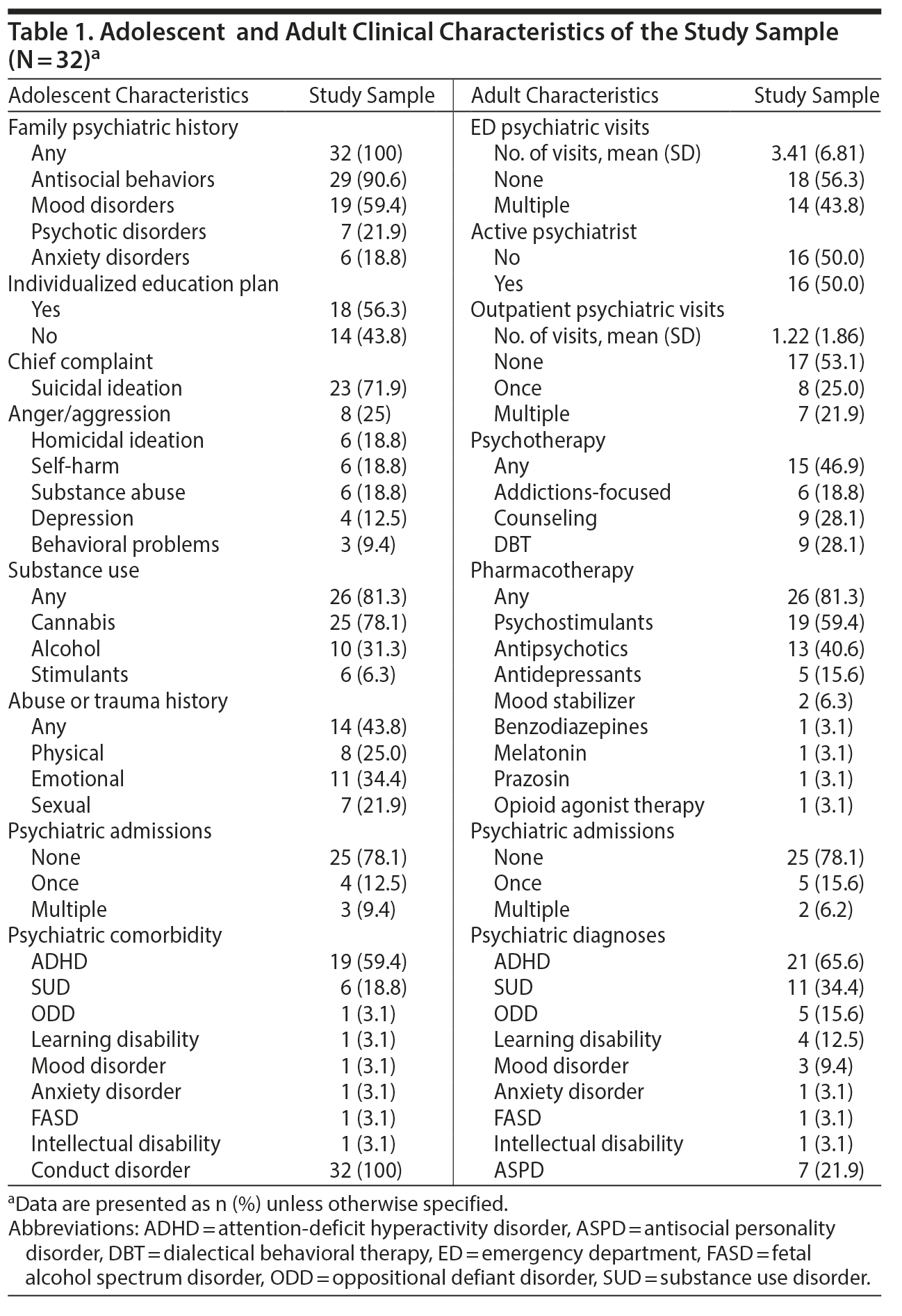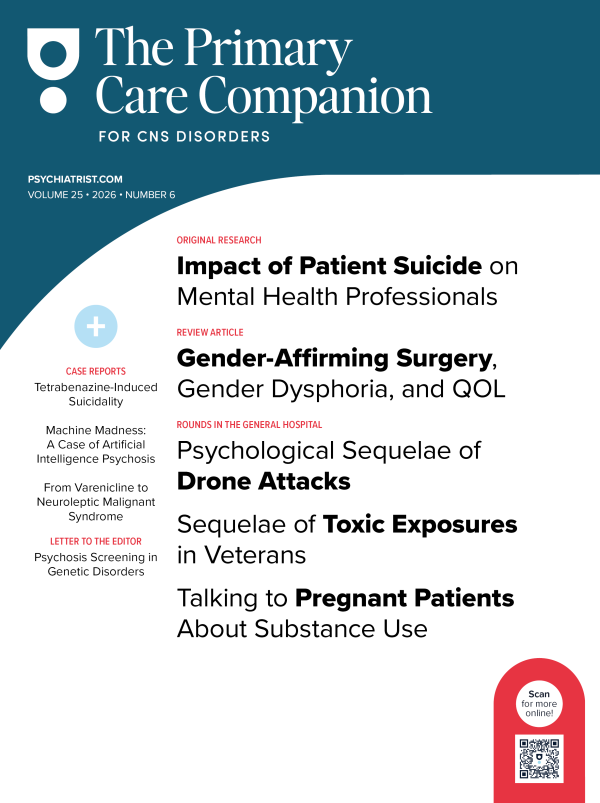Five-Year Follow-Up for Adolescents With Conduct Disorder Referred to an Urgent Psychiatric Consult Clinic: A Descriptive Study
To the Editor: The publication1 on the incidence rates of treated mental disorders in children and adolescents inspired us to revisit the idea of clinical trajectories in individuals with conduct disorder.
Conduct disorder (CD) is diagnosed in children or adolescents displaying persistent patterns of behavior violating the basic rights of others.2 Prevalence estimates of CD vary widely from 0.2% to 8.7%.3 CD is increasingly viewed as a neurobiological syndrome involving antisocial behaviors and callous unemotional traits.4 Genetic studies5,6 have identified patterns of heritability. Autonomic hypoarousal,7 depressed serotonergic and opioid neurotransmission,7,8 reduced brain glucose metabolism,9 and white matter alterations in the corpus collosum10 may underpin abnormal emotion processing, behavioral control, and reward-related learning associated with CD.
As there are no evidence-based treatments for CD, pharmacologic11 and psychosocial interventions12 are largely applied to treatable comorbidities. Recently, urgent psychiatric consultation services for high-risk adolescents have emerged as potential harm-reduction venues.13,14 This study aimed to describe the adult clinical trajectories of a cohort of adolescents diagnosed with CD after referral to an urgent psychiatry service using a retrospective record-linkage approach.
Methods. After seeking ethics approval, we retrospectively identified a cohort of all adults (≥ 18 years old) diagnosed with CD after assessment at a university-affiliated child and adolescent mental health urgent consult clinic (CAMHUCC). Details of the study were published previously.13-15 After linking CAMHUCC records with several regional databases, we extracted relevant characteristics at baseline and 5-year follow-up to establish a clinical trajectory. We used SPSS16 to conduct basic descriptive and inferential analyses (using a significance threshold of .05).
Results. Our cohort consisted of 32 individuals (characteristics are described in Table 1). At initial presentation, the mean age was 15.3 years (SD = 1.05), 69.1% were male, 91.1% reported a family history of CD, 81.3% reported substance use, 43.8% reported abuse, and 37.5% were registered with children’s aid. Suicidal ideation (71.9%) and aggression/anger (25.0%) were the most common reasons for referral. Attention-deficit/hyperactivity disorder (ADHD) (59.4%) and substance use disorders (SUDs) (18.8%) were the most commonly diagnosed comorbidities.
After transitioning to adult services, there were a mean of 3.41 (SD = 1.86) emergency psychiatry visits, 0.38 (SD = 0.98) psychiatric admissions, and 1.22 (SD = 1.86) outpatient psychiatry appointments. ADHD (65.6%), SUD (34.4%), and antisocial personality disorder (ASPD) (21.9%) were the most commonly diagnosed adult comorbidities, with 81.3% on psychotropic medications and 46.9% in psychotherapy.
Logistic regression—accounting for sex, abuse, comorbidity, and family history—was statistically significant, explaining 38.9% (Nagelkerke R2) of the variance in adult ASPD diagnostic status, correctly classifying 78.1% of cases. Males were 18.1 times more likely to develop ASPD than females (95% CI, 1.2-287.0; P = .039).
Discussion. Our study indicates that adolescents with CD who were referred to urgent psychiatric services have persistent psychiatric comorbidity and continue to require mental health services in adulthood. Of our sample, 21.9% received a diagnosis of ASPD in adulthood, with male sex the only statistically significant predictor for ASPD diagnosis. While this rate is lower than previous estimates of 40% for males with CD,17 we cannot make a causal inference about CAMHUCC’s role.
While our study had minimal attrition, the small sample size and absence of a suitable control group restricted the extent and power of our analysis. As the sample considered by this study comes from an urgent consultation clinic, the severity of the CD presentations considered is likely to be higher than what would typically be seen in other outpatient settings. While our findings may not be generalizable to other CD populations, they do suggest that males with CD are at greater risk of developing ASPD and may benefit from intensive and focused harm-reduction interventions. In a similar vein, future studies comparing the clinical characteristics of adolescents with CD across various settings may be of value to enhance the body of knowledge regarding CD.
References
1.Steinhausen H-C, Jakobsen H. Incidence rates of treated mental disorders in childhood and adolescence in a complete nationwide birth cohort. J Clin Psychiatry. 2019;80(3):17m12012. PubMed CrossRef
2.American Psychiatric Association. Diagnostic and Statistical Manual for Mental Disorders. Fifth Edition. Washington, DC: American Psychiatric Association; 2013.
3.Sarkhel S, Sinha VK, Arora M, et al. Prevalence of conduct disorder in schoolchildren of Kanke. Indian J Psychiatry. 2006;48(3):159-164. PubMed CrossRef
4.Puzzo I, Seunarine K, Sully K, et al. Altered white-matter microstructure in conduct disorder is specifically associated with elevated callous-unemotional traits. J Abnorm Child Psychol. 2018;46(7):1451-1466. PubMed CrossRef
5.Eisenbarth H, Demetriou CA, Kyranides MN, et al. Stability subtypes of callous-unemotional traits and conduct disorder symptoms and their correlates. J Youth Adolesc. 2016;45(9):1889-1901. PubMed CrossRef
6.Salvatore JE, Dick DM. Genetic influences on conduct disorder. Neurosci Biobehav Rev. 2018;91:91-101. PubMed CrossRef
7.Scarpa A, Raine A. Psychophysiology of anger and violent behavior. Psychiatr Clin North Am. 1997;20(2):375-394. PubMed CrossRef
8.Bandelow B, Wedekind D. Possible role of a dysregulation of the endogenous opioid system in antisocial personality disorder. Hum Psychopharmacol. 2015;30(6):393-415. PubMed CrossRef
9.Goyer PF, Andreason PJ, Semple WE, et al. Positron-emission tomography and personality disorders. Neuropsychopharmacology. 1994;10(1):21-28. PubMed CrossRef
10.Waller R, Dotterer HL, Murray L, et al. White-matter tract abnormalities and antisocial behavior: a systematic review of diffusion tensor imaging studies across development. Neuroimage Clin. 2017;14:201-215. PubMed CrossRef
11.Muzina DJ, Gao K, Kemp DE, et al. Acute efficacy of divalproex sodium versus placebo in mood stabilizer-naive bipolar I or II depression: a double-blind, randomized, placebo-controlled trial. J Clin Psychiatry. 2011;72(6):813-819. PubMed CrossRef
12.Stevens KA, Ronan PK, Davies G. Treating conduct disorder: an effectiveness and natural language analysis study of a new family-centred intervention program. Psychiatry Res. 2017;251:287-293. PubMed CrossRef
13.Roberts N, Booij L, Axas N, et al. Two-year prospective study of characteristics and outcome of adolescents referred to an adolescent urgent psychiatric clinic. Int J Adolesc Med Health. 2016;30(1):ijamh-2016-0006. PubMed CrossRef
14.Alavi N, Roberts N, Sutton C, et al. Bullying victimization (being bullied) among adolescents referred for urgent psychiatric consultation: prevalence and association with suicidality. Can J Psychiatry. 2015;60(10):427-431. PubMed CrossRef
15.Pikard J, Roberts N, Groll D. Pediatric referrals for urgent psychiatric consultation: clinical characteristics, diagnoses and outcome of 4 to 12 year old children. J Can Acad Child Adolesc Psychiatry. 2018;27(4):245-251. PubMed
16.SPSS Statistics for Mac Version 25.0 [computer program]. Armonk, NY: IBM Corp; 2017.
17.Black DW. The natural history of antisocial personality disorder. Can J Psychiatry. 2015;60(7):309-314. PubMed CrossRef
aDepartment of Psychiatry, Queen’s University, Kingston, Ontario, Canada
bDepartment of Public Health Sciences, Queen’s University, Kingston, Ontario, Canada
cDivision of Child and Youth Mental Health, Hotel Dieu Hospital, Department of Psychiatry, Queen’s University, Kingston, Ontario, Canada
Published online: June 4, 2020.
Potential conflicts of interest: None.
Funding/support: None.
Acknowledgments: The authors wish to acknowledge Nicholas Axas, MSW, and Leanne Repetti, MSW, from the Division of Child and Youth Mental Health of the Department of Psychiatry of Queen’s University (Kingston, Ontario, Canada) for maintaining the CAMHUCC database. Mr Axas and Ms Repetti have no conflicts of interest related to the subject of this letter.
Prim Care Companion CNS Disord 2020;22(3):19l02489
To cite: Bahji A, Gillis K, Sharma S, et al. Five-year follow-up for adolescents with conduct disorder referred to an urgent psychiatric consult clinic: a descriptive study. Prim Care Companion CNS Disord. 2020;22(3):19l02489.
To share: https://doi.org/10.4088/PCC.19l02489
© Copyright 2020 Physicians Postgraduate Press, Inc.
Please sign in or purchase this PDF for $40.00.



